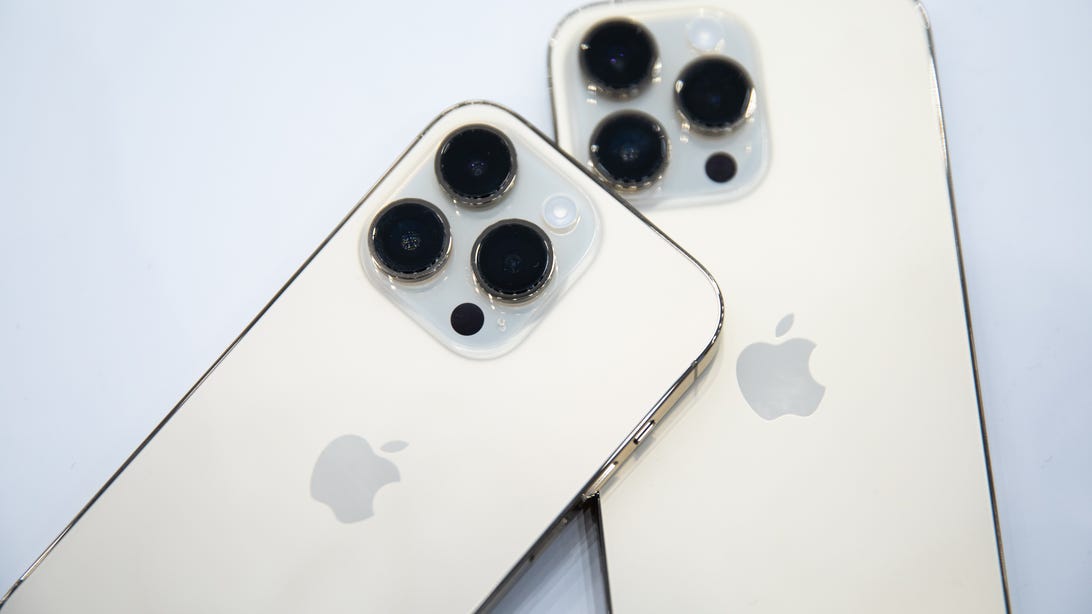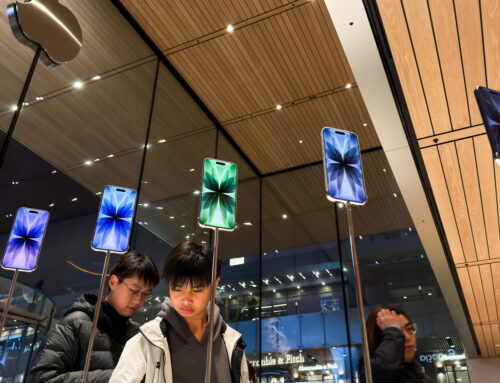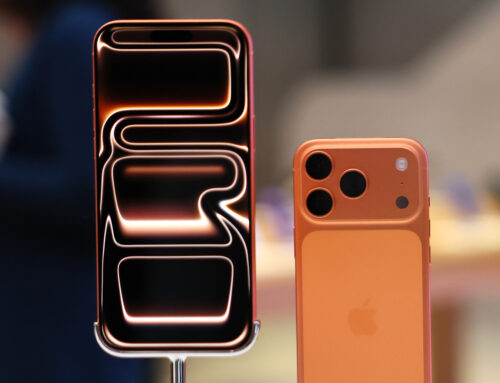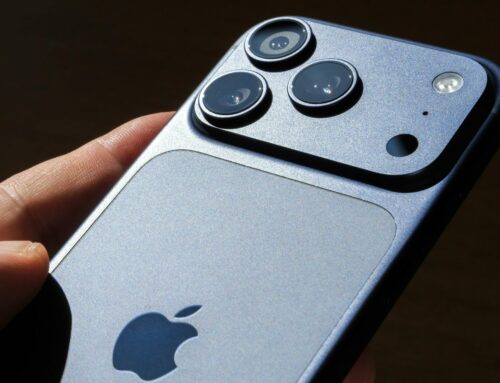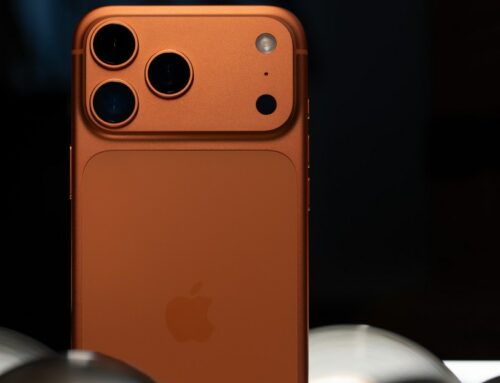This story is part of Focal Point iPhone 2022, CNET’s collection of news, tips and advice around Apple’s most popular product.
Apple unveiled its brand-new iPhones at its “Far Out” event on Wednesday, but reserved its biggest changes for its iPhone 14 Pro and iPhone 14 Pro Max models. The new standout feature: The iPhone 14 Pro and 14 Pro Max each lack a notch. In its place is a small pill-shaped screen cutout that houses a revamped TrueDepth camera unit for Face ID, selfies and video calls.
Rather than ignore the cutout, Apple built a system of moving alerts and notifications called the Dynamic Island, which occupies the black space around it. Strange name aside, the feature is compelling in person and looks cool.
The Dynamic Island, not present on the iPhone 14 or iPhone 14 Plus, is just one of the ways Apple widened the gap between Pro and non-Pro iPhone models. Another way is price: The iPhone 14 Pro starts at $999, $200 more than the iPhone 14. The 14 Pro costs the same price as previous Pro models and the iPhone X, which debuted in 2018. But some people will be put off by the 14 Pro’s price, or that of the 14 Pro Max, which starts at $1,099.
(If you missed the Apple event on Wednesday, check out our live blog. Plus, here’s what to know about the newly announced AirPods Pro 2, Apple Watch 8, Apple Watch Ultra and iOS 16 release date.)
iPhone 14 Display: Goodbye notch, hello Dynamic Island
From the back, the iPhone 14 Pro doesn’t look that much different from last year’s flagship, the iPhone 13 Pro. But from the front, the 14 Pro’s display cutout looks contemporary and fresh compared the notch on the 13 Pro. The first thing I noticed picking up an iPhone 14 Pro was that the infamous notch was gone. The pill-shaped display cutout is so much smaller in comparison.
Apple’s Dynamic Island interface works so well, too. For example, I was listening to a song playing in Apple Music. When I closed the app there was a tiny waveform on one side of the cutout and a minute thumbnail of the album’s artwork on the other. When I tapped on the Dynamic Island, I was immediately taken to the song in the Apple Music app.
The cutout is just one part of the Super Retina XDR display, which can now hit 2,000 nits of brightness for better visibility in bright light. By contrast, the iPhone 13 Pro maxes out at 1,200 nits of brightness. The 14 Pro uses LTPO, or low-temperature polycrystalline oxide, technology to bring the refresh rate down to 1Hz, which could help save on battery drain and allow for the always-on display. The 13 Pro’s LTPO screen bottoms out at 10Hz.
iPhone 14 Pro’s A16 Bionic: The new chip for 2022
Apple A16 Bionic chip.
Apple
There’s also the new A16 Bionic chip which this year is just reserved for Pro models. The iPhone 14 and 14 Plus use the same version of the A15 Bionic chip found in last year’s iPhone 13 Pro. The A16 chip’s high-performance cores, for demanding tasks like gaming, use 20% less power than those on the A15 chip.
The A16 chip includes 16 billion transistors on a 4-nanometer process versus 15 billion transistors on the A15’s 5-nanometer process. The jump in computational power might not be as significant from the 13 Pro to the 14 Pro as it was from the 12 Pro to 13 Pro. It’s also uncertain how much RAM the iPhone 14 Pro will have as Apple historically doesn’t share iPhone memory details.
The GPU sees an upgrade as well, with 50% more memory bandwidth. The display engine on the A16 Bionic chip helps power the LTPO display as well as the Dynamic Island. Apple says the A16 Bionic’s neural engine is capable of 17 trillion operations per second, which is needed for computational photography.
In my few minutes with the iPhone 14 Pro and 14 Pro Max, the system animations seemed smooth and iOS 16 was peppy.
iPhone 14 Pro Camera: Pixel binning arrives on the iPhone
The iPhone 14 Pro will have a 48-megapixel camera. The quad-pixel sensor uses pixel binning to group four pixels and have them act as one large pixel for better light capture. Android phones including the Galaxy S22 Ultra employ a similar technique with high-megapixel camera sensors. The handset’s Pro Raw mode allows photos to be captured at its full 48-megapixel resolution.
Apple developed a new computational image-processing method to take advantage of the new pixel pattern for better color accuracy and detail. It’s called Photonic Engine, which improves the iPhone Pro’s camera performance two times in low-light compared with the iPhone 13 Pro. The 14 Pro and 14 Pro Max can also use the 48-megapixel sensor to “punch-in” a photo, emulating a 2x zoom with the middle 12-megapixels of the sensor.
Read more: Why the iPhone 14 Pro’s 48MP Camera Deserves the Attention
The Photonic Engine processing also benefits the ultrawide camera with a three times improvement in low-light photos, and two times better on telephoto and front-facing camera photos.
Apple said the iPhone 14 Pro will come with Pro Video and Cinematic modes that can now record at 4K and 24 frames per second. Both Pro models also get Apple’s new video image stabilization which is called Action mode. Essentially when you are filming a video, on the top-left corner of the camera preview is the Action mode icon. When I tried it out, it seemed to work well smoothing out hand-shakes. I noticed that if I had video resolution set to 4K that Action mode reduced it down to 2.8K.
iPhone 14 Pro’s camera bump and new TrueDepth camera display cutout.
Apple
iPhone 14 Pro vs. iPhone 13 Pro
With the release of the iPhone 14 Pro and 14 Pro Max, Apple also discontinued the iPhone 13 Pro and 13 Pro Max. Even though Apple isn’t selling last year’s Pro models doesn’t mean it’s entirely gone. Various third-party retailers and carriers might continue to sell the old Pro. But should you get an iPhone 13 Pro or and iPhone 14 Pro?
In terms of features, hardware and lifespan the iPhone 14 Pro seems to outshine the iPhone 13 Pro in nearly every way. However, sometimes there isn’t a drastic difference between the two phones. If you own an iPhone 13 Pro it looks like upgrading to the iPhone 14 Pro is unnecessary. But if you have an older iPhone and are trying to choose between the two, I’d likely push you towards the newer 14 Pro, unless you’re getting an absolute killer discount on the 13 Pro.
iPhone 14 Pro: Battery life, price and other features
Apple said the iPhone 14 Pro will feature all-day battery life, longer than previous models. It’ll also include the newly unveiled features found in the base iPhone 14, such as Emergency SOS via satellite, a satellite-based system for communication in cellular and Wi-Fi dead zones, and Crash Detection, which lets the device know if you’ve been in a car accident.
The upcoming iOS 16 will be the operating system powering Apple’s iPhone 14 line out of the box.
The iPhone 14 Pro will start at $999 (£1,099, AU$1,749). The 14 Pro Max will start at $1,099 (£1,199, AU$1,899). Both of Apple’s premium handsets are more expensive than the base iPhone 14 and 14 Plus devices, which start at $799 (£849, AU$1,399) and $899 (£949, AU$1,579) respectively.
Preorders start on Sept. 9, with the phones launching on Sept. 16.
iPhone 14 vs. iPhone 14 Plus vs. iPhone 14 Pro vs. iPhone 14 Pro Max
| iPhone 14 | iPhone 14 Plus | iPhone 14 Pro | iPhone 14 Pro Max | |
|---|---|---|---|---|
| Display size, resolution | 6.1-inch OLED; 2,532×1,170 pixels | 6.7-inch OLED; 2,778×1,284 pixels | 6.1-inch Super Retina XDR, OLED display, 2,556×1,179 pixels | 6.7-inch Super Retina XDR, OLED display, 2,796×1,290 pixels |
| Pixel density | 460 ppi | 458 ppi | 460 ppi | 460 ppi |
| Dimensions (inches) | 5.78 x 2.82 x 0.31 in. | 6.33 x 3.07 x 0.31 in. | 5.81 x 2.81 x 0.31 in. | 6.33 x 3.05 x 0.31 in. |
| Dimensions (millimeters) | 147 x 72 x 7.8mm | 161 x 78 x 7.8mm | 147.5 x 71.5 x 7.85mm | 160.7 x 77.6 x 7.85mm |
| Weight (ounces, grams) | 6.07 oz.; 172g | 7.16 oz.; 203g | 7.27 oz.; 206g | 8.47 oz.; 240g |
| Mobile software | iOS 16 | iOS 16 | iOS 16 | iOS 16 |
| Rear cameras | 12MP (wide), 12MP (ultrawide) | 12MP (wide), 12MP (ultrawide) | 48MP (wide), 12MP (ultrawide), 12MP (telephoto) | 48MP (wide), 12MP (ultrawide), 12MP (telephoto) |
| Front-facing camera | 12-megapixel | 12-megapixel | 12-megapixel | 12-megapixel |
| Video capture | HDR video recording with Dolby Vision up to 4K at 60 fps | HDR video recording with Dolby Vision up to 4K at 60 fps | HDR video recording with Dolby Vision up to 4K at 60 fps | HDR video recording with Dolby Vision up to 4K at 60 fps |
| Processor | Apple A15 Bionic | Apple A15 Bionic | Apple A16 Bionic | Apple A16 Bionic |
| Storage | 128GB, 256GB, 512GB | 128GB, 256GB, 512GB | 128GB, 256GB, 512GB, 1TB | 128GB, 256GB, 512GB, 1TB |
| RAM | Undisclosed | Undisclosed | Undisclosed | Undisclosed |
| Expandable storage | No | No | No | No |
| Battery | Undisclosed; Apple lists 20 hours of video playback | Undisclosed; Apple lists 26 hours of video playback | Undisclosed; Apple lists 29 hours of video playback | Undisclosed; Apple lists 29 hours of video playback |
| Fingerprint sensor | No (Face ID) | No (Face ID) | No (Face ID) | No (Face ID) |
| Connector | Lightning | Lightning | Lightning | Lightning |
| Headphone jack | No | No | No | No |
| Special features | 5G enabled; MagSafe; water resistant (IP68); wireless charging; dual-SIM capabilities (e-SIM) | 5G enabled; MagSafe; water resistant (IP68); wireless charging; dual-SIM capabilities (e-SIM) | Dynamic Island; Always-On display; 5G enabled; MagSafe; water resistant (IP68); wireless charging; dual-SIM capabilities (e-SIM) | Dynamic Island; Always-On display; 5G enabled; MagSafe; water resistant (IP68); wireless charging; dual-SIM capabilities (e-SIM) |
| Price off-contract (USD) | $799 (128GB), $899 (256GB), $1,099 (512GB) | $899 (128GB), $999 (256GB), $1,199 (512GB) | $999 (128GB), $1,099 (256GB), $1,299 (512GB), $1,499 (1TB) | $1,099 (128GB), $1,199 (256GB), $1,399 (512GB), $1,599 (1TB) |
| Price (GBP) | £849 (128GB) | £949 (128GB) | £1,099 (128GB) | £1,199 (128GB) |
| Price (AUD) | AU$1,399 (128GB) | AU$1,579 (128GB) | AU$1,749 (128GB) | AU$1,899 (128GB) |

